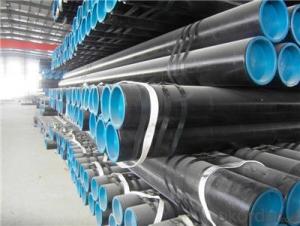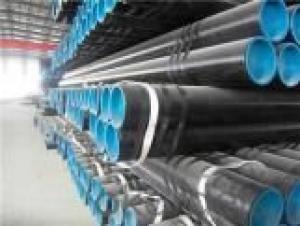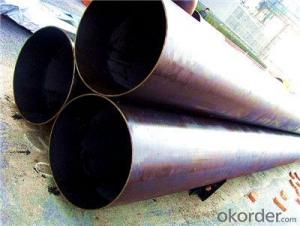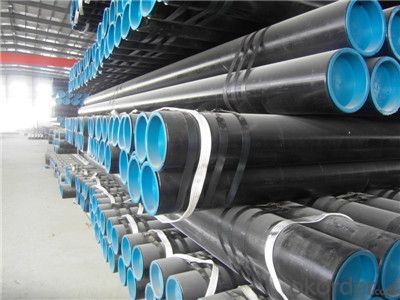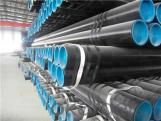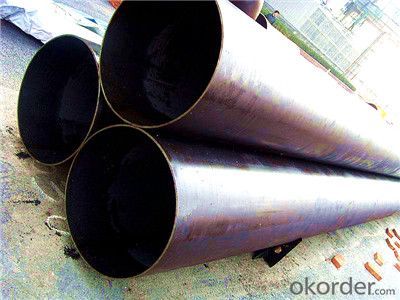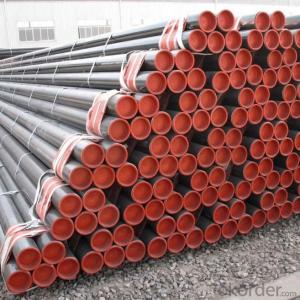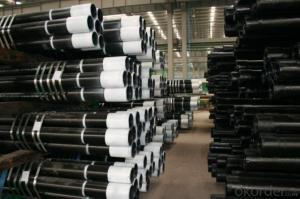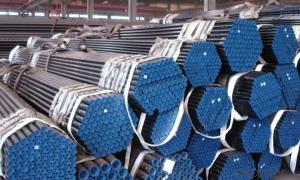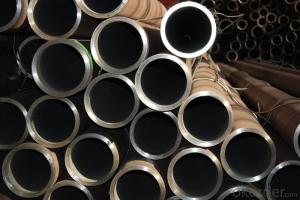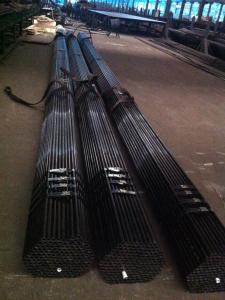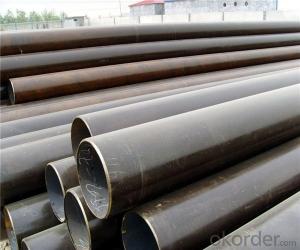Steel Pipe SCH40/80/STD With High Quality and Best Price
- Loading Port:
- Tianjin
- Payment Terms:
- TT or LC
- Min Order Qty:
- 100 m.t.
- Supply Capability:
- 1000 m.t./month
OKorder Service Pledge
OKorder Financial Service
You Might Also Like
1、Structure of Seamless Pipe SCH40/80/STD:
Seamless pipe is formed by drawing a solid billet over a piercing rod to create the hollow shell. As the manufacturing process does not include any welding, seamless pipes are perceived to be stronger and more reliable. Historically seamless pipe was regarded as withstanding pressure better than other types, and was often more easily available than welded pipe.
2、Main Features of theSeamless Pipe SCH40/80/STD:
• High manufacturing accuracy
• High strength
• Small inertia resistance
• Strong heat dissipation ability
• Good visual effect
• Reasonable price
3、Seamless Pipe SCH40/80/STD Specification:
Standard | GB, DIN, ASTM ASTM A106-2006, ASTM A53-2007 |
Grade | 10#-45#, 16Mn 10#, 20#, 45#, 16Mn |
Thickness | 8 - 33 mm |
Section Shape | Round |
Outer Diameter | 133 - 219 mm |
Place of Origin | Shandong, China (Mainland) |
Secondary Or Not | Non-secondary |
Application | Hydraulic Pipe |
Technique | Cold Drawn |
Certification | API |
Surface Treatment | factory state or painted black |
Special Pipe | API Pipe |
Alloy Or Not | Non-alloy |
Length | 5-12M |
Outer Diameter | 21.3-610mm |
Grade | 20#, 45#, Q345, API J55, API K55, API L80, API N80, API P110, A53B |
Standard | ASME, ASTM |
1) Material:20#(ASTM A 106/A53 GRB.API5LGRB,GB),45#,16Mn,10#.
2) Specification range:OD:21.3-610mm,WT:6-70mm,length:6-12m or according to the requirement of clients.
3) Excutive standards:GB,ASME API5L.ASTM A 106/A53,Despite of the above standards,we can also supply seamless steel pipe with standard of DIN,JIS,and so on,and also develop new products according to the requirements of our clients!
4) Surface:black lacquered,varnish coating or galvanized.
5) Ends:Beveled or square cut,plastic capped,painted.
6) Packing:bundles wrapped with strong steel strip,seaworthy packing.
4、Packaging & Delivery
Packaging Details: | seaworthy package,bundles wrapped with strong steel strip |
Delivery Detail: | 15-30days after received 30%TT |
5、FAQ of Seamless Pipe SCH40/80/STD:
①How is the quality of your products?
Our products are manufactured strictly according to national and internaional standard, and we take a test
on every pipe before delivered out. If you want see our quality certifications and all kinds of testing report, please just ask us for it.
Guaranteed: If products’ quality don’t accord to discription as we give or the promise before you place order, we promise 100% refund.
②How about price?
Yes, we are factory and be able to give you lowest price below market one, and we have a policy that “ for saving time and absolutely honest business attitude, we quote as lowest as possible for any customer, and discount can be given according to quantity”,if you like bargain and factory price is not low enough as you think, just don’t waste your time.Please trust the quotation we would give you, it is professional one.
③Why should you chose us?
Chose happens because of quality, then price, We can give you both.Additionally, we can also offer professional products inquiry, products knowledge train(for agents), smooth goods delivery, exellent customer solution proposals.Our service formula: good quality+good price+good service=customer’s trust
SGS test is available, customer inspection before shipping is welcome, third party inspection is no problem.
Any question, pls feel free to contact us !
6、Seamless Pipe SCH40/80/STD Images:
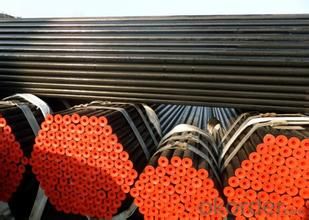
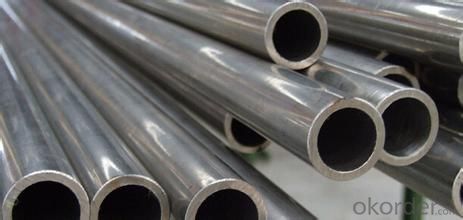
- Q: What are the different types of supports used for aboveground steel pipes?
- There are several types of supports used for aboveground steel pipes, including pipe hangers, pipe shoes, pipe clamps, and pipe rollers. These supports are designed to provide stability, prevent sagging, and distribute the weight of the pipe evenly, ensuring the structural integrity of the system.
- Q: How are steel pipes used in the agricultural irrigation systems?
- Steel pipes are commonly used in agricultural irrigation systems due to their durability and strength. These pipes are used to transport water from a water source, such as a well or a reservoir, to the fields where crops are grown. One of the main advantages of using steel pipes in agricultural irrigation systems is their ability to withstand high pressure and heavy loads. This makes them suitable for transporting large volumes of water over long distances without the risk of bursting or breaking. Steel pipes also have a high resistance to corrosion, which is important in agricultural settings where the pipes may come into contact with fertilizers or other chemicals. In addition to their durability, steel pipes provide a smooth interior surface that helps to minimize friction and maintain a consistent water flow. This is crucial in irrigation systems as it ensures that the water is evenly distributed across the fields, promoting optimal crop growth. Furthermore, steel pipes can be easily connected and configured to match the specific layout and requirements of the irrigation system. Overall, steel pipes play a vital role in agricultural irrigation systems by facilitating the efficient and reliable transport of water to crops. Their strength, durability, resistance to corrosion, and smooth interior surface make them an ideal choice for these applications.
- Q: What is the difference between seamless steel pipe and welded pipe?
- Such as hydraulic equipment pipeline connection. The weld seam of common steel pipe is its weak link, and the quality of weld is the main factor that affects its overall performance. People who have lived in the north have experienced the experience of freezing pipes and pipes in winter, and the places where they burst are usually welds. Welded pipe is not seamless steel pipe.
- Q: How do you connect steel pipes together?
- Steel pipes can be connected together using various methods such as welding, threading, flanges, or mechanical couplings. Welding involves fusing the ends of the pipes together using heat, while threading involves cutting grooves into the pipe ends and screwing them together. Flanges are used to connect pipes using bolts and gaskets, providing a secure and leak-proof joint. Mechanical couplings utilize compression fittings or clamps to connect pipes without the need for welding or threading. The appropriate method depends on the specific application, pipe size, and project requirements.
- Q: How are steel pipes tested for leaks?
- Steel pipes can be tested for leaks using various methods, including hydrostatic testing, pneumatic testing, and using leak detection equipment such as ultrasonic testing or helium testing.
- Q: Can steel pipes be used for conveying slurry?
- Yes, steel pipes can be used for conveying slurry. Steel pipes are commonly used in industries such as mining, dredging, and wastewater treatment, where slurry - a mixture of solid particles and liquid - needs to be transported. Steel pipes offer high strength, durability, and resistance to abrasion, making them suitable for handling the abrasive nature of slurry. Additionally, steel pipes can be lined or coated with materials such as rubber or ceramic to further enhance their resistance to wear and corrosion, making them a reliable choice for conveying slurry.
- Q: How do you calculate the thermal expansion of steel pipes?
- In order to determine the thermal expansion of steel pipes, it is necessary to utilize the coefficient of thermal expansion (CTE) specific to steel. The CTE represents the extent to which a material expands or contracts in response to temperature fluctuations. Typically, the average value of CTE for steel is around 12 x 10^-6 per degree Celsius (12 μm/m°C). To calculate the thermal expansion of a steel pipe, one must possess knowledge of the pipe's initial length (L0), the temperature change (ΔT), and the CTE for steel. The formula for calculating thermal expansion is as follows: ΔL = L0 * CTE * ΔT In this equation: ΔL denotes the alteration in length of the steel pipe L0 represents the initial length of the steel pipe CTE signifies the coefficient of thermal expansion for steel ΔT indicates the change in temperature For instance, suppose there is a steel pipe with an initial length of 2 meters (L0), and the temperature rises by 50 degrees Celsius (ΔT). The CTE for steel is 12 x 10^-6 per degree Celsius. ΔL = 2m * 12 x 10^-6/°C * 50°C ΔL = 0.00024m/m°C * 50°C ΔL = 0.012m Thus, when the temperature increases by 50 degrees Celsius, the steel pipe will expand by 0.012 meters or 12 millimeters. It is important to bear in mind that this calculation assumes linear expansion, which is applicable for minor temperature variations. However, for larger temperature differences or more intricate pipe systems, a more comprehensive analysis may be necessary to consider factors such as the material properties, geometry, and thermal boundary conditions of the pipes.
- Q: What is a flange and how is it used in steel pipes?
- A flange is a mechanical joint used to connect two sections of steel pipes or other equipment together. It consists of a ring or plate with evenly spaced holes for bolts or welding. Flanges are used in steel pipes to provide a secure and leak-proof connection. They allow for easy assembly and disassembly of pipes, as well as provide a connection point for additional components like valves, fittings, or other pipe accessories.
- Q: Can steel pipes be painted?
- Yes, steel pipes can be painted. The process typically involves cleaning and preparing the surface, applying a primer, and then using a suitable paint or coating to achieve the desired finish.
- Q: Are steel pipes resistant to fire?
- Yes, steel pipes are highly resistant to fire.
Send your message to us
Steel Pipe SCH40/80/STD With High Quality and Best Price
- Loading Port:
- Tianjin
- Payment Terms:
- TT or LC
- Min Order Qty:
- 100 m.t.
- Supply Capability:
- 1000 m.t./month
OKorder Service Pledge
OKorder Financial Service
Similar products
Hot products
Hot Searches
Related keywords
